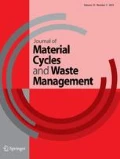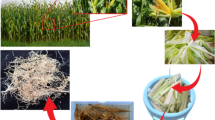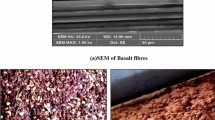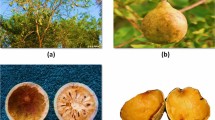Abstract
Jatropha seed cake particulate (JSCP)-reinforced epoxy composites were prepared by open mold resin casting method. The influence of JSCP on mechanical and dry sliding wear properties of epoxy was experimentally investigated as per the ASTM standards. Dry sliding wear test was conducted for these composites at a constant sliding distance of 500 m with different sliding velocities and applied loads by a pin-on-disc wear test machine. The results revealed that incorporation of JSCP decreased the specific wear rate and coefficient of friction while improving the mechanical properties. The composite reinforced with 40 wt% of JSCP exhibited better mechanical properties and wear behavior compared to the neat epoxy and other compositions of JSCP/epoxy composites. The results of this study indicate that jatropha seed cake powder can be used as biosolid lubricant filler for epoxy.
















Similar content being viewed by others
References
Katz HS, Mileski JV (1987) In: Handbook of fillers for plastics, Von Nostrand Reinhold, New York
Pieter S, Jan Q, Wouter O, Patrick DB, Gustaaf S (2005) Sliding behavior of pure polyester and polyester-PTFE filled bulk composites in overload conditions. Polym Test 24:588–603
Basavarajappa S, Elangovan S, Arun KV (2009) Studies on dry sliding wear behavior of graphite filled glass-epoxy composites. Mater Design 30:2670–2675
Basavarajappa S, Arun KV, Paulo DJ (2009) Effect of filler materials on dry sliding wear behaviour of polymer matrix composites—a Taguchi approach. J Miner Mater Character Eng 8:379–391
Li D, Xie Y, Li W, You Y, Deng X (2013) Tribological and mechanical behaviors of polyamide-6/glass fiber composite filled with solid lubricants. Sci World J 13 doi:10.1155/2013/320837
Zhang X, Pei X, Wang Q (2010) Friction and wear behavior of basalt-fabric-reinforced/solid lubricant filled phenolic composites. J Appl Polym Sci 117:3428–3433
Srivastava VK, Shembekar PS (1990) Tensile and fracture properties of epoxy resin filled with fly ash particles. J Mater Sci 25(8):3513–3516
Atzeni C, Massidda L, Sanna U (1990) Mechanical properties of epoxy mortars with fly ash as filler. Cement Concrete Compos 12(1):3–8
Elshaarani MT, Yaakob Z, Dahlan KZM, Mohammad M (2013) Jatropha deoiled cake filler-reinforced medium-density polyethylene biocomposites: effect of filler loading and coupling agent on the mechanical, dynamic mechanical and morphological properties. Polym Compos 34(5):746–756
Mohan N, Natarajan S, Kumaresh Babu SP, Siddaramaiah (2010) Investigation on sliding wear behaviour and mechanical properties of jatropha oil cake-filled glass-epoxy composites. J Am Oil Chem Soc 88:111–117
ASTM D6980-12 (2012) Standard test method for determination of moisture in plastics by loss in weight. In: ASTM international, June 2012
ASTM D792-08 (2012) Standard test methods for density and specific gravity (relative density) of plastics by displacement. In: ASTM international, June 2012
ASTM D638-10 (2012) Standard test method for tensile properties of plastics. In: ASTM international, June 2012
ASTM D790-10 (2012) Standard test methods for flexural properties of unreinforced and reinforced plastics and electrical insulating materials. In: ASTM international, June 2012
ASTM D5229 (2010) Standard test method for moisture absorption properties and equilibrium conditioning of polymer matrix composite materials. In: ASTM international, doi:10.1520/D5229_D5229M-12
ASTM G99-05 (2012) Standard test method for wear testing with a pin-on-disk apparatus. In: ASTM international, August 2012
(2013) http://rsb.info.nih.gov/ij/. Accessed 01 March 2013
Shivamurthy B, Bhat KU, Anandhan S (2013) Mechanical and sliding wear properties of multi-layered laminates from glass fabric/graphite/epoxy composites. Mater Design 44:136–143
Bijwe J, Awtade S, Satapathy BK, Ghosh A (2004) Influence of concentration of aramid fabric on abrasive wear performance of polyethersulfone composites. Tribol Lett 17:187–194
Poomalai P, Siddaramaiah Suresha B, Lee JH (2008) Mechanical and three body abrasive wear behavior of PMMA/TPU blends. Mater Sci Eng A 492:486–490
Acknowledgments
The authors are thankful to the Karnataka state biofuel development board for the financial support given to carry out this research work.
Author information
Authors and Affiliations
Corresponding author
Rights and permissions
About this article
Cite this article
Shivamurthy, B., Murthy, K., Joseph, P.C. et al. Mechanical properties and sliding wear behavior of jatropha seed cake waste/epoxy composites. J Mater Cycles Waste Manag 17, 144–156 (2015). https://doi.org/10.1007/s10163-014-0235-0
Received:
Accepted:
Published:
Issue Date:
DOI: https://doi.org/10.1007/s10163-014-0235-0




